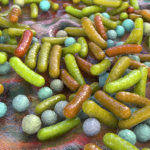By David Blyweiss, M.D., Advanced Natural Wellness
August 24, 2015
- Are modern-day antibiotics affecting your mobility?
- Here’s what to watch out for…
- …And what you can do instead
When you take an antibiotic, I’ll bet you don’t think much about potential side effects. After all, these drugs are safe, right? They halt infections that could otherwise be deadly.
Well, not all antibiotics are created equal.
And there’s a newer class of antibiotics that may cure what ails you, but not without serious risk. Especially when it comes to your mobility.
They’re called fluoroquinolones. You’ll be able to spot them easily, because their names typically end in floxacin. Ciprofloxacin, which you might know as cipro, is a perfect example.
Now, unlike most antibiotics, these drugs are synthetic. But the biggest threat comes from the addition of fluoride molecules. Fluoride helps the drug penetrate tissue that’s hard to get into, like your brain.
MD Exposes the Hidden Danger to Your Eyes

When your eyesight starts to fail, it's a real problem. Suddenly you can't go to the grocery store... you can't get to the doctor if you have an emergency... you can't meet your friends for dinner…
Your "regular" doctor doesn't have time to keep up with the latest research. And the same goes for eye doctors. They go to school to learn how to fit you for glasses and contacts, but have no way of preventing the damage and loss of eyesight that threatens your freedom and independence.
Let me show you something that explains a LOT about how your eyes work.
In my FREE Special Report, I'll show you a HUGE, untapped resource for your eyes that safely and naturally restores clear, effortless eyesight.
Click here to get started...
Well, guess what? Fluoride is a neurotoxin. Once it gets into your brain, it can damage your central nervous system.
So it’s no surprise that fluoroquinolones can cause severe nerve damage. In fact, they increase your chance of peripheral neuropathy by just over 80%. This is nerve damage that can affect your arms, hands, legs and feet. It causes weakness, pain and numbness that can interfere with your daily activities.
It’s especially brutal on the feet and legs. That’s because neuropathy makes it difficult to walk, run, climb stairs and maintain balance.
Plus, if you experience numbness in your feet, it seriously raises the risk of taking a stumble and falling. Your foot could even get a cut or burn that becomes infected, and you wouldn’t even know it.
This debilitating condition can occur at any time during treatment with fluoroquinolones. Even after stopping the drug, it can last for months or years – or become permanent.
Besides nerve damage, these drugs are also associated with pain, swelling, inflammation and ruptures of the tendons. These, too, can become permanent and limit your mobility.
Other health issues include liver toxicity and irregular heart beat, along with blood sugar highs and lows. And as with all antibiotics, they seriously disturb the gut microbiota that protects your immune system and guards against all sorts of health disorders.
Now I’m not saying to avoid taking an antibiotic if you really need one. But if at all possible, ask your doctor for an older, narrow-spectrum antibiotic that targets your specific problem.
Are You Suffering From...
- Love handles and a pot belly
- Romance that isn't what it used to
- Forgetfulness and inattention
- Low (or no) strength and endurance
- A sex drive that's shifted into neutral...or worse
If so...you may have Mature Male Burnout. Click here to discover more about this unique condition and what you can do about it.
Many of these older drugs are safer. Plus, they haven’t been used as the first line of defense in recent years. This might actually make them more effective against some of today’s most common bacterial infections. (By the way, always make sure to take a hefty daily dose of probiotics any time you use any type of antibiotic.)
In the meantime, there are several natural antibiotics. They aren’t too expensive. So it’s easy to place all of them in your arsenal to defeat bacterial infections without drugs.
Manuka honey has strong antibacterial activity. This honey works where antibiotics and antiseptics don’t. It can be effective against MRSA, E. coli and h. pylori. It also accelerates wound healing, so it’s good for treating cuts, burns, skin infections and bed sores.
To get the best results, make sure to purchase medical grade manuka honey. Look for labels with a high UMF rating. This indicates the concentration of the product. A rating of 10 should be the minimum.
Tea tree oil is a very effective antibacterial, antiseptic and antifungal agent. It’s great for wound healing. It’s also good for fungal infections and acne. And like manuka honey, it can help treat MRSA infections. There is a warning however – It should never be ingested or used near the eyes.
It comes in different concentrations, so you’ll need to choose one that’s right for your condition. For example, acne treatment requires only a 5% concentration. But you’ll probably need a 100% concentration for a stubborn fungal infection.
Colloidal silver is a wonder antibiotic. It has the ability to destroy over 650 microorganisms (including MRSA) at very low concentrations. It’s potent enough that burn units use it to prevent skin infections in patients.
Be sure to stick with products designated as “true colloidal silver”. These are the safest and most pure preparations. I recommend Natural-immunogenics “argentyn 23.”
Sources:
Valdez-Jiménez L, et al. Effects of the fluoride on the central nervous system. Neurologia. 2011 Jun;26(5):297-300.
Etminan M, et al. Oral fluoroquinolone use and risk of peripheral neuropathy: a pharmacoepidemiologic study. Neurology. 2014 Sep 30;83(14):1261-3.
Lewis T, et al. Fluoroquinolones and tendinopathy: a guide for athletes and sports clinicians and a systematic review of the literature. J Athl Train. 2014 May-Jun;49(3):422-7.
Alshammari TM, et al. Risk of hepatotoxicity associated with fluoroquinolones: a national case-control safety study. Am J Health Syst Pharm. 2014 Jan 1;71(1):37-43.
Lapi F, et al. Fluoroquinolones and the risk of serious arrhythmia: a population-based study. Clin Infect Dis. 2012 Dec;55(11):1457-65.
Mehlhorn AJ, et al. Safety concerns with fluoroquinolones. Ann Pharmacother. 2007 Nov;41(11):1859-66.
Mandal MD, et al. Honey: its medicinal property and antibacterial activity. Asian Pac J Trop Biomed. Apr 2011; 1(2): 154-160.
Halcón L, et al. Staphylococcus aureus and wounds: a review of tea tree oil as a promising antimicrobial. Am J Infect Control. 2004 Nov;32(7):402-8.
Iroha, et al. Antibacterial efficacy of colloidal silver alone and in combination with other antibiotics on isolates from wound Infections. Scientific Research and Essays. 2007. 2.8: 338-341.






